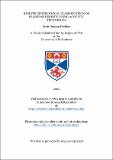Files in this item
Remote geotechnical classification of seabed sediments using acoustic techniques
Item metadata
| dc.contributor.advisor | Green, C.D. | |
| dc.contributor.advisor | McManus, John | |
| dc.contributor.author | Hadden, Scott Duncan | |
| dc.coverage.spatial | 310 p. | en_US |
| dc.date.accessioned | 2018-06-12T13:05:24Z | |
| dc.date.available | 2018-06-12T13:05:24Z | |
| dc.date.issued | 2002 | |
| dc.identifier.uri | https://hdl.handle.net/10023/13953 | |
| dc.description.abstract | Although the sonar amplitude of return is undoubtedly determined by the acoustic-sediment interaction at the seabed, the raw amplitude of return is of little practical use to geotechnical engineers. By focusing upon the relationships between the strength of the acoustic scattering and the roughness of the surficial seabed sediments, this research aims to derive a remote acoustic methodology that can be used to predict the geotechnical characteristics of the seabed sediment. The main field survey areas selected were Loch Earn, Scotland, and the Portsmouth coastal waters in the Solent, England, with the precise location of the field sites being determined by the distribution of differing sediment types. The sonar data was acquired by a 234kHz Interferometric Seabed Inspection Sonar system, which provided not only high precision and high resolution, but also extensive and very dense data coverage. These sonar datasets were then complemented by a sediment ground-truthing programme within the same area. Using trigonometry and the 'sonar equation' parameters, the complex post-processing of the bathymetric and acoustic data resulted in the generation of an acoustic roughness measurement. The sediment grain size analysis then followed standard techniques to derive values for the statistical roughness parameters of the sediment. The correlation between the acoustic and sediment roughness uncovered a good correlation between the mean grain size and also the finest modal value, with an increase in acoustic scattering strength reflecting an increase in the mean and finest modal grain sizes. The reversal of this correlation therefore enables a prediction of mean or finest modal grain size, thereby demonstrating an approach towards an 'unsupervised' acoustic sediment classification scheme. This study was carried out over a very narrow grain size range, from muds to fine sands, and therefore the addition of sonar datasets recorded over coarser sediments are required to complete the classification scheme. | en_US |
| dc.language.iso | en | en_US |
| dc.publisher | University of St Andrews | |
| dc.subject.lcc | GC380.2A25H2 | |
| dc.title | Remote geotechnical classification of seabed sediments using acoustic techniques | en_US |
| dc.type | Thesis | en_US |
| dc.type.qualificationlevel | Doctoral | en_US |
| dc.type.qualificationname | PhD Doctor of Philosophy | en_US |
| dc.publisher.institution | The University of St Andrews | en_US |
This item appears in the following Collection(s)
Items in the St Andrews Research Repository are protected by copyright, with all rights reserved, unless otherwise indicated.

